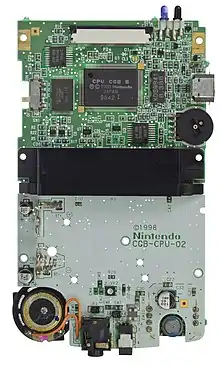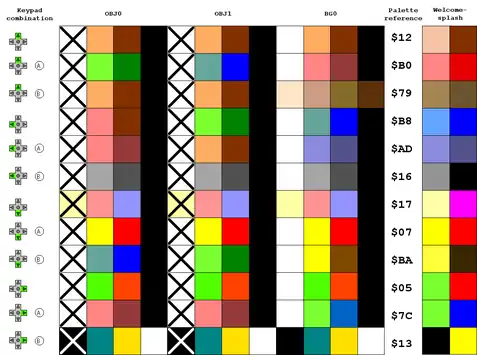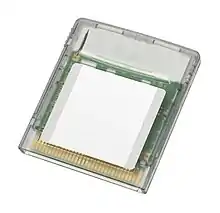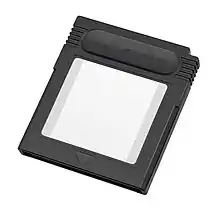 | |
 The Atomic Purple version | |
| Also known as | GBC / CGB-001 |
|---|---|
| Developer | Nintendo Research & Engineering |
| Manufacturer | Nintendo |
| Product family | Game Boy[1] |
| Type | Handheld game console |
| Generation | Fifth |
| Release date | |
| Introductory price | US$79.95 (equivalent to $140 in 2022)[2] |
| Discontinued | Yes; date undisclosed |
| Units shipped | 118.69 million (including the Game Boy) |
| Media | Game Boy Game Pak Game Boy Color Game Pak |
| CPU | Sharp LR35902 core @ 4.19/8.38 MHz |
| Memory | 32 KB RAM 16 KB VRAM |
| Display | TFT LCD 160 x 144 pixels, 44x40 mm[3] |
| Online services | Mobile System GB[4] |
| Best-selling game | Pokémon Gold and Silver, approximately 23 million units |
| Backward compatibility | Game Boy |
| Predecessor | Game Boy[5] |
| Successor | Game Boy Advance[5] |
The Game Boy Color (commonly abbreviated as GBC) is an 8-bit handheld game console, manufactured by Nintendo, which was released in Japan on October 21, 1998[6] and to international markets that November. It is the successor to the Game Boy and is part of its product line. Critics like IGN consider it more akin to a hardware revision than a next generation product.[7]
The handheld features a color screen rather than monochrome, but it is not backlit. It is slightly thicker and taller and features a slightly smaller screen than the Game Boy Pocket, its immediate predecessor. As with the original Game Boy, it has a custom 8-bit processor made by Sharp that is considered a hybrid between the Intel 8080 and the Zilog Z80.[8] The American English spelling of the system's name, Game Boy Color, remains consistent throughout the world.
The GBC is part of the fifth generation of video game consoles. The Game Boy and the Game Boy Color combined have sold 118.69 million units worldwide making them the fourth best-selling system of all time.[9][10] Its best-selling games are Pokémon Gold and Silver, which shipped 23 million units worldwide.[11][12]
History
Development for the Game Boy Color began in 1996,[13] when Nintendo received requests from game developers for a more sophisticated handheld platform, who said that even the latest iteration of the original system, the Game Boy Pocket, had insufficient hardware. Nintendo developed the console concurrently with Project Atlantis. The resultant product was backward compatible with all existing Game Boy software, a first for a handheld system, allowing each new Game Boy product launch to begin with a significantly larger game library than any of its competitors.
Nintendo formally announced the release of the Game Boy Color on 10 March 1998.[14] All remaining new units were sold by March 31, 2003.[9]
Hardware
Technical specifications
The technical specifications for the console are as follows:[15]
| Size | Approximately 78 mm × 133.5 mm × 27.4 mm (3.07 in × 5.26 in × 1.08 in) (WxHxD) |
|---|---|
| Weight | Approximately 138 g (4.9 oz)[16] |
| Screen | 2.3 inch reflective thin-film transistor (TFT) color liquid-crystal display (LCD)
|
| Display size | 44 by 40 mm (1.7 by 1.6 in)[16] |
| Framerate | 59.727500569606 Hz[17] |
| Power | Internal: 2× AA batteries[18] External: 3V DC 0.6W (2.35mm × 0.75mm) Red LED indicator |
| Battery life | Up to 10 hours of gameplay |
| CPU | 4.194304/8.388608 MHz (effective speed 1.0485 (speed of original Game Boy) or 2.097 MHz) Sharp Corporation LR35902 (custom hybrid between the Intel 8080 and the Zilog Z80) |
| Memory | 32 KB RAM; 16 KB VRAM |
| Resolution | 160 (w) × 144 (h) pixels (10:9 aspect ratio; same aspect ratio and resolution as the original Game Boy) |
| Color support | Palette colors available: 32,768 (15-bit) Colors on screen: Supports 10, 32 or 56 |
| Sound | 2 square wave channels, 1 wave channel, 1 noise channel, mono speaker, stereo headphone jack |
| Input |
|
Game Paks manufactured by Nintendo have the following specifications:
- ROM: 8 MB maximum
- Cartridge RAM: 128 KB maximum
Without additional mapper hardware, the maximum ROM size is 32 KB (256 kbit).

The processor, which is a hybrid Intel 8080 and Zilog Z80 workalike made by Sharp with a few extra (bit manipulation) instructions, has a clock speed of approximately 8 MHz, twice as fast as that of the original Game Boy.[lower-alpha 1] The Game Boy Color has three times as much memory as the original (32 KB system RAM, 16 KB video RAM). The screen resolution is the same as the original Game Boy at 160×144 pixels.
The Game Boy Color features an infrared communications port for wireless linking. The feature is only supported in a small number of games, so the infrared port was dropped from the Game Boy Advance line, to be later reintroduced with the Nintendo 3DS, though wireless linking would return in the Nintendo DS line using Wi-Fi. The console is capable of displaying up to 56 different colors simultaneously on screen from its palette of 32,768 (8×4 color background palettes, 8x3+transparent sprite palettes), and can add basic four-, seven- or ten-color shading to games that had been developed for the original 4-shades-of-grey Game Boy. In the 7-color modes, the sprites and backgrounds are given separate color schemes, and in the 10-color modes the sprites are further split into two differently-colored groups; however, as flat black (or white) was a shared fourth color in all but one (7-color) palette, the overall effect is that of 4, 6, or 8 colors. This method of upgrading the color count results in graphic artifacts in certain games; for example, a sprite that is supposed to meld into the background is sometimes colored separately, making it easily noticeable. Manipulation of palette registers during display allows for a rarely used high color mode, capable of displaying more than 2,000 colors on the screen simultaneously.[20]
Color palettes
| Directional pad | Action button | ||
|---|---|---|---|
| None (default) | A | B | |
| Up | Brown | Red | Dark brown |
| Down | Pale yellow | Orange | Yellow |
| Left | Blue | Dark blue | Gray |
| Right | Green | Dark green | Reverse |
For dozens of select Game Boy games, the Game Boy Color has an enhanced palette built-in featuring up to 16 colors—four colors for each of the Game Boy's four layers.[21] If the system does not have a palette stored for a game, it defaults to the "Dark green" palette. However, at power-up, one of 12 built-in color palettes is selectable by pressing a directional button and optionally A or B while the Game Boy logo is present on the screen.
These palettes each contain up to ten colors.[22] In most games, the four shades displayed on the original Game Boy translate to different subsets of this 10-color palette, such as by displaying movable sprites in one subset and backgrounds in another. The grayscale (Left + B) palette produces an appearance similar to that experienced on the original Game Boy, Game Boy Pocket, or Game Boy Light.

Games with special palettes include:
- Donkey Kong
- Golf
- Kirby's Dream Land
- Kirby's Dream Land 2
- Kirby's Pinball Land
- Metroid II: Return of Samus
- Pokémon Red and Blue
- Pokémon Yellow (Japanese version)
- Super Mario Land
- Super Mario Land 2: 6 Golden Coins
- Tetris
- Wario Land: Super Mario Land 3
| 0x00 | 0x10 |
| 0x01 | 0x11 |
| 0x02 | 0x12 |
| 0x03 | 0x13 |
| 0x04 | 0x14 |
| 0x05 | 0x15 |
| 0x06 | 0x16 |
| 0x07 | 0x17 |
| 0x08 | 0x18 |
| 0x09 | 0x19 |
| 0x0A | 0x1A |
| 0x0B | 0x1B |
| 0x0C | 0x1C |
| 0x0D | 0x1D |
| 0x0E | 0x1E |
| 0x0F | 0x1F |
A few games used a scan-line color switch technique to increase the number of colors available on-screen to more than 2,000. This "Hi-Color mode" was used by licensed developers including 7th Sense. Some examples of games using this technique are The Fish Files, The New Addams Family Series, and Alone in the Dark: The New Nightmare.[20] Cannon Fodder uses this technique to render full motion video segments in the introduction sequence, ending, and main menu screen.[23]
Cartridges


Game Boy Color exclusive games are housed in clear-colored Game Pak cartridges.[24] They are shaped differently than original Game Boy Game Paks. Notably, these cartridges lack a notch that prevented the original Game Paks from being removed while the original Game Boy was powered on due to a plastic piece attached to the power switch, which would slide over the notch, locking a cartridge inside the system during gameplay (although some special cartridges like Kirby Tilt 'n' Tumble[25] do include this notch). The lack of this notch keeps original Game Boy systems loaded with Game Boy Color cartridges from powering on. Similarly, Game Boy Pocket, Super Game Boy, Super Game Boy 2, and Game Boy Light will power on when loaded with a Game Boy Color cartridge but will refuse to load the game and will display a warning message stating that a Game Boy Color system is required. This same warning message can be viewed on an original Game Boy as well if the piece that slides into the notch is cut out of the Game Boy. Some Game Boy cartridges such as Chee-Chai Alien[26][27] and Pocket Music[28] cannot be played on Game Boy Advance and Game Boy Advance SP systems. When inserted and powered on, these systems will exhibit a similar error message and will not load the game. Black cartridges are backwards compatible, playable on the original Game Boy.
Model colors
The logo for Game Boy Color spells out the word "COLOR" in the five original colors in which the unit was manufactured: Berry (C), Grape (O), Kiwi (L), Dandelion (O), and Teal (R).
Another color released at the same time was "Atomic Purple", made of a translucent purple plastic similar to the color available for the Nintendo 64 controller. Other colors were sold as limited editions or in specific countries.
Games
Due to its backward compatibility with Game Boy games, the Game Boy Color's launch period had a large playable library. The system amassed a library of 576 Game Boy Color games over a four-year period. While the majority of the games are Game Boy Color exclusive, approximately 30% of the games released are compatible with the original Game Boy. Most Game Boy Color games released after 1999 are not compatible with the original Game Boy.
Tetris for the original Game Boy is the best-selling game compatible with Game Boy Color, and Pokémon Gold and Silver are the best-selling games developed primarily for it. The best-selling Game Boy Color exclusive game is Pokémon Crystal.
The last Game Boy Color game ever released is the Japanese exclusive Doraemon no Study Boy: Kanji Yomikaki Master, on July 18, 2003. The last game released in North America is Harry Potter and the Chamber of Secrets, released on November 15, 2002. In Europe the last game released for the system is Hamtaro: Ham-Hams Unite!, on January 10, 2003.
Reception
Sales
The Game Boy and Game Boy Color were both commercially successful, selling a combined 32.47 million units in Japan, 44.06 million in the Americas, and 42.16 million in other regions.[9][10] At the time of its discontinuation in 2003, the combined sales of the Game Boy were the best-selling game console of all time. Surpassed in sales by the Nintendo DS, PlayStation 2 and Nintendo Switch the trio are now the fourth-best-selling console, the third-best-selling console and the second-best-selling handheld of all time. Sales of the console were in part driven by the success of Pokémon Gold and Silver and Pokémon Crystal, with combined sales of 29.5 million units, making them one of the best selling-video games of all time.
Sales of the Game Boy Color were strong at launch. Nintendo of America reported a sale of one million units from launch to December 1998,[29] and two million by July 1999.[30] Retail chains in the United States reported unexpectedly high demand for the console, with executives of FuncoLand reporting "very pleasant and unpredicted" sales and Electronics Boutique stating "the entire Game Boy Color line just exploded, including accessories" upon release.[31] Faced with high worldwide demand and competitive retail pricing, retailers such as CompUSA sold out of Game Boy Color stock in the weeks before the 1998 Christmas season.[29]
Critical reception
Reception of the Game Boy Color was positive, with critics praising the addition of color and improved clarity of the display. Affiliated publications such as Total Game Boy praised the handheld for its "bright, colorful picture that can be viewed in direct light", backward compatibility features preserving the "vast catalogue of original Game Boy games", and improved technical performance.[32] Computer and Video Games praised the Game Boy Color for making the Game Boy library of games "look better than ever - everything is crystal clear, bright and in colour".[33] Writing for GameSpot, Chris Johnston stated that the display was "crystal clear" and free of motion blur, stating that Tetris DX was the "killer app" of the launch titles on the platform.[34] Milder reviews included those by Arcade, who conceded that the colors were "very impressive" but "not as eyeball-popping as you might have hoped for [...] it's mostly seaweed greens, rusty browns, timid yellows and the like". They concluded that "nothing about [the Game Boy Color] is very radical" but also said the device was "Game Boy as it always should have been".[35]
Legacy
Commentary on the legacy of the Game Boy Color has been shaped by the perception that the handheld was as an incremental and transitional upgrade of the Game Boy rather than a completely new handheld release.[13][36] In a history of Nintendo, author Jeff Ryan noted the Game Boy Color had a reputation as a "legacy machine" that found success mostly due to its backward compatibility, as "few wanted to lose all the Dr. Mario and Pokémon cartridges they had amassed over the years."[37] Quoted in Retro Gamer, Blitz Games Studios developer Bob Pape acknowledged that although "backwards compatibility more or less defined (the) Game Boy Color", the handheld "ticked all the right boxes with regards to size, battery life, reliability and most importantly backwards compatibility".[36]
Positive assessment on the legacy of the Game Boy Color has also focused upon the merits of its game library, particularly for its third-party and import titles. Travis Fahs for IGN noted whilst "the Game Boy Color's life was relatively brief", it "built up a small library of excellent games", including Wario Land 3 and Pokémon Gold and Silver, and a "unique" and "previously unheard of" line of successful third-party games, including Dragon Warrior Monsters, Metal Gear Solid and Yu-Gi-Oh! Dark Duel Stories.[13] Ashley Day of Retro Gamer noted that the handheld had an "overlooked" status, stating "the Game Boy Color (has) an unfair reputation as the one Nintendo handheld with few worthwhile titles, but this simply isn't the case...returning to the Game Boy Color now reveals a wealth of great games that you never knew existed, especially those available on import."[38]
See also
Notes
References
- ↑ Ishihara; Morimoto. "Pokémon HeartGold Version & Pokémon SoulSilver Version". Iwata Asks (Interview: Transcript). Interviewed by Satoru Iwata. Nintendo. Archived from the original on November 24, 2022. Retrieved September 25, 2022.
- ↑ "Introducing Game Boy Color". Nintendo Power. p. 85: Nintendo. November 1998.
{{cite magazine}}: CS1 maint: location (link) - ↑ "Technical data". Nintendo of Europe GmbH. Archived from the original on February 7, 2023. Retrieved May 24, 2017.
- ↑ "モバイルシステムGB". Nintendo (in Japanese). Archived from the original on November 28, 2015. Retrieved September 23, 2015.
- 1 2 Umezu; Sugino; Konno. "Nintendo 3DS (Volume 2 – Nintendo 3DS Hardware Concept)". Iwata Asks (Interview: Transcript). Interviewed by Satoru Iwata. Nintendo. Archived from the original on March 29, 2012. Retrieved March 7, 2011.
- ↑ "Game Boy Color hardware". www.nintendo.co.jp. Archived from the original on May 25, 2022. Retrieved July 24, 2016.
- ↑ Fahs, Travis (July 27, 2009). "IGN Presents the History of Game Boy". IGN. Retrieved February 20, 2023.
- ↑ "The Nintendo® Game Boy™, Part 1: The Intel 8080 and the Zilog Z80". RealBoy. January 2, 2013. Archived from the original on May 10, 2022. Retrieved August 29, 2017.
- 1 2 3 "Consolidated Sales Transition by Region" (PDF). Nintendo. April 26, 2016. Archived from the original (PDF) on October 11, 2016. Retrieved October 23, 2016.
- 1 2 "A Brief History of Game Console Warfare: Game Boy". BusinessWeek. McGraw-Hill. Archived from the original on May 9, 2007. Retrieved March 28, 2008.
- ↑ "Japan Platinum Game Chart". The Magic Box. Archived from the original on December 13, 2007. Retrieved September 27, 2007.
- ↑ "US Platinum Videogame Chart". The Magic Box. Archived from the original on April 21, 2007. Retrieved September 27, 2007.
- 1 2 3 Fahs, Travis (July 27, 2009). "IGN Presents the History of Game Boy". IGN. Archived from the original on May 28, 2010. Retrieved August 6, 2022.
- ↑ "Nintendo Announces Full Color Game Boy". Nintendo. March 10, 1998. Archived from the original on May 30, 1998.
- ↑ "Nintendo Game Boy Color Console Information – Console Database". ConsoleDatabase.com. Archived from the original on July 2, 2011. Retrieved February 19, 2011.
- 1 2 "Technical data". Nintendo of Europe GmbH. Archived from the original on February 7, 2023. Retrieved February 4, 2018.
- ↑ "TASVideos / Platform Framerates". tasvideos.org. Archived from the original on February 29, 2020. Retrieved February 29, 2020.
- ↑ "Adding Color to Game Boy". Electronic Gaming Monthly. No. 106. Ziff Davis. May 1998. p. 26.
- ↑ "CPU Instruction Set - Pan Docs". Archived from the original on August 17, 2022. Retrieved August 17, 2022.
- 1 2 "First Alone in the Dark Screenshots for Game Boy Color". IGN. August 4, 2000. Archived from the original on April 3, 2015. Retrieved March 24, 2015.
- ↑ "Disassembling the GBC Boot ROM". Archived from the original on December 3, 2020. Retrieved August 13, 2020.
- ↑ "Changing the Color Palette on Game Boy Advance Systems". Customer Service. Nintendo. Archived from the original on January 13, 2009. Retrieved January 4, 2009.
- ↑ Albatross, Zen (November 18, 2011). "Game Boy Games That Pushed The Limits of Graphics & Sound". Racketboy. Archived from the original on April 2, 2015. Retrieved March 24, 2015.
- ↑ "Game Pak Troubleshooting - All Game Boy Systems". Nintendo of America customer support. Archived from the original on September 28, 2017. Retrieved September 27, 2017.
- ↑ "Kirby Tilt & Tumble - Cartridge". www.vgfacts.com. Archived from the original on August 1, 2019. Retrieved June 28, 2018.
- ↑ "プレイ日記 ゲームボーイ最強伝説 ちっちゃいエイリアン 近所のオバチャンに聞いたら「あのメグ・ライアンが絶賛した」とか言っていた!??". valken.obihimo.com. Archived from the original on March 7, 2021. Retrieved June 28, 2018.
- ↑ "中古 [ゲーム/GB] ちっちゃいエイリアン (ゲーム... - ヤフオク!". ヤフオク! (in Japanese). Archived from the original on February 24, 2021. Retrieved June 28, 2018.
- ↑ "Gameboy Genius » Blog Archive » Pocket Music GBC version GBA fix". blog.gg8.se. Archived from the original on May 18, 2015. Retrieved June 28, 2018.
- 1 2 "Game Boy Color Sales Exceed 1 Million During Holidays". Gaming Intelligence: 4. February 1999.
- ↑ Dunne, Alex (July 1999). "Industry Watch". Game Developer Magazine: 10.
- ↑ Trainman, Steve (May 12, 1999). "Retailers Coming to E3 with High Expectations". Game Week. 5 (17).
- ↑ "Introducing The Game Boy Color". Total Game Boy (1). 1998.
- ↑ "Portable Colour Gaming Is Here!". Computer and Video Games (205). December 1998.
- ↑ Johnston, Chris (1998). "Hands On: Game Boy Color". GameSpot. Archived from the original on June 7, 2019. Retrieved November 13, 2022.
- ↑ "The Color Purple". Arcade (1): 60–61. December 1998.
- 1 2 Carroll, Martyn (December 2018). "Game Boy Color". Retro Gamer (187): 50–55.
- ↑ Ryan, Jeff (September 25, 2012). Super Mario: How Nintendo Conquered America. Penguin Random House. p. 208. ISBN 978-1591845638.
- ↑ Day, Ashley (May 2006). "Game Boy Color" (24): 41–43.
{{cite journal}}: Cite journal requires|journal=(help)
External links
- Official website
- Game Boy Color at Nintendo.com (archived versions at the Internet Archive Wayback Machine)
- Wayback Machine at Nintendo.com (archived from "the original" (PDF). Archived from the original (PDF) on September 3, 2006. at the Internet Archive Wayback Machine)
- Game Boy Color at Curlie
- Nintendo Announces Full Color Game Boy - ROME (March 10, 1998)